Toyota C-HR vs Ferrari 296 Targa – Differences & prices compared
Compare performance, boot space, consumption and price in one view.
Find out now: which car is the better choice for you – Toyota C-HR or Ferrari 296 Targa?
The Toyota C-HR (SUV) comes with a Full Hybrid or Plugin Hybrid engine and Automatic transmission. In comparison, the Ferrari 296 Targa () features a engine with transmission.
When it comes to boot capacity, the Toyota C-HR offers 447 L, while the Ferrari 296 Targa provides – depending on how much space you need. If you’re looking for more power, decide whether the 223 HP of the Toyota C-HR or the of the Ferrari 296 Targa suits your needs better.
In terms of consumption, the values are 0.80 L per 100 km for the Toyota C-HR, and for the Ferrari 296 Targa.
Price-wise, the Toyota C-HR starts at 29100 £, while the Ferrari 296 Targa is available from . Compare all the details and find out which model fits your lifestyle best!
Toyota C-HR
The Toyota C-HR stands out with its distinctive and bold design that combines sleek, angular lines with a sporty posture. Its comfortable and stylish interior is equipped with advanced technology features, providing a seamless driving experience. The vehicle offers impressive handling and performance, making it a compelling choice for those who appreciate a blend of practicality and flair on the road.
details @ Toyota
@ Toyota
 @ Toyota
@ Toyota
 @ Toyota
@ Toyota
 @ Toyota
@ Toyota
 @ Toyota
@ Toyota
Ferrari 296 Targa
The Ferrari 296 Roadster captivates with its harmonious blend of cutting-edge technology and classic design, offering a thrilling open-top driving experience. Its powerful hybrid powertrain delivers exhilarating performance while maintaining an emphasis on efficiency and sustainability. The interior combines luxurious materials and advanced connectivity features, ensuring drivers remain engaged and comfortable during every journey.
details @ Ferrari
@ Ferrari
 @ Ferrari
@ Ferrari

|

|
|
|
|
Costs and Consumption |
|
|---|---|
|
Price
29100 - 42800 £
|
Price
-
|
|
Consumption L/100km
0.8 - 5.1 L
|
Consumption L/100km
-
|
|
Consumption kWh/100km
-
|
Consumption kWh/100km
-
|
|
Electric Range
68 km
|
Electric Range
-
|
|
Battery Capacity
-
|
Battery Capacity
-
|
|
co2
17 - 115 g/km
|
co2
-
|
|
Fuel tank capacity
43 L
|
Fuel tank capacity
-
|
Dimensions and Body |
|
|---|---|
|
Body Type
SUV
|
Body Type
-
|
|
Seats
5
|
Seats
-
|
|
Doors
5
|
Doors
-
|
|
Curb weight
1505 - 1755 kg
|
Curb weight
-
|
|
Trunk capacity
350 - 447 L
|
Trunk capacity
-
|
|
Length
4362 mm
|
Length
-
|
|
Width
1832 mm
|
Width
-
|
|
Height
1558 - 1564 mm
|
Height
-
|
|
Payload
375 - 425 kg
|
Payload
-
|
Engine and Performance |
|
|---|---|
|
Engine Type
Full Hybrid, Plugin Hybrid
|
Engine Type
-
|
|
Transmission
Automatic
|
Transmission
-
|
|
Transmission Detail
-
|
Transmission Detail
-
|
|
Drive Type
Front-Wheel Drive, All-Wheel Drive
|
Drive Type
-
|
|
Power HP
140 - 223 HP
|
Power HP
-
|
|
Acceleration 0-100km/h
7.4 - 9.9 s
|
Acceleration 0-100km/h
-
|
|
Max Speed
175 - 180 km/h
|
Max Speed
-
|
|
Torque
-
|
Torque
-
|
|
Number of Cylinders
4
|
Number of Cylinders
-
|
|
Power kW
103 - 164 kW
|
Power kW
-
|
|
Engine capacity
1798 - 1987 cm3
|
Engine capacity
-
|
General |
|
|---|---|
|
Model Year
2024 - 2025
|
Model Year
-
|
|
CO2 Efficiency Class
C, B
|
CO2 Efficiency Class
-
|
|
Brand
Toyota
|
Brand
-
|
Toyota C-HR
Revolutionising the Crossover Segment: The Toyota C-HR
The Toyota C-HR has firmly established itself as a standout contender in the compact crossover segment. Known for its distinct design and hybrid capabilities, the C-HR continues to prioritise innovation and efficiency. In this article, we delve into the technical details that make the 2024 iteration a compelling choice for discerning buyers.
Distinctive Design and Aerodynamics
The Toyota C-HR boasts a striking design that combines angular lines with modern aesthetics. This isn't merely for show; the design enhances aerodynamics, improving fuel efficiency and handling. With dimensions of 4362mm in length and a sophisticated structure, the C-HR strikes a balance between urban agility and on-road stability.
Impressive Hybrid Powertrains
The C-HR lineup offers innovative hybrid and plug-in hybrid drivetrain options. The full hybrid system is tailored for those who seek both economic and environmental benefits. It combines a petrol engine with an electric motor to deliver power outputs ranging from 140 to 223 PS, achieving remarkable fuel consumption rates from 0.8 to 5.1 L/100km. The 2.0 Plug-In Hybrid variant impresses with an electric range of 67 km, ideal for urban commuters.
Unmatched Efficiency and Performance
Acceleration figures for the C-HR range from 7.4 to 9.9 seconds to reach 0-100 km/h, ensuring a responsive driving experience. Maximum speeds between 175 and 180 km/h cater to those who appreciate a bit of zest on the open road. Coupled with CVT automatic transmission and both front-wheel and all-wheel-drive configurations, the C-HR adapts to various driving conditions with ease.
Advanced Technology and Features
Inside, the C-HR is equipped with the latest technology aimed at providing connectivity and comfort. The model hosts an array of features across its diverse trim levels, including Business Edition, Lounge, and the sporty GR SPORT. Each variant is designed to meet the demands of different lifestyles, ensuring there's a C-HR model to suit every taste.
Sustainability and Cost Efficiency
With CO2 emissions ranging from 19 to 115 g/km, the C-HR stands as a testament to Toyota's commitment to sustainability. Financially savvy consumers will also appreciate the running cost, with monthly expenses from €959 to €1204, and a cost per km as low as 38.4 cents. Such efficiency makes the vehicle an attractive option for eco-minded buyers.
Conclusion: A Forward-Thinking Choice
The 2024 Toyota C-HR embodies Toyota's forward-thinking approach to automotive innovation, blending eco-friendly hybrid technologies with stylish design and practicality. It offers a glimpse into the future of driving, where efficiency meets elegance. Whether you're a city dweller or an adventure seeker, the C-HR promises a driving experience that is both enjoyable and environmentally conscious.
Ferrari 296 Targa
An Introduction to the Ferrari 296 Roadster
The Ferrari 296 Roadster represents a new era in the legendary manufacturer's lineup, combining impressive engineering with stunning design. As the latest iteration in Ferrari's roadster ensemble, this model encapsulates the brand's commitment to pushing boundaries in the world of sports cars.
Design and Aesthetics
The 296 Roadster boasts an exquisite design that seamlessly fuses traditional Ferrari elements with modern aesthetics. The vehicle's sleek lines and sculpted curves enhance its aerodynamic profile, ensuring both beauty and performance are in perfect harmony. The retractable hardtop exemplifies Ferrari's engineering prowess, offering an open-air driving experience without compromising on style or function.
Hybrid Powertrain Innovation
Under the bonnet, the Ferrari 296 Roadster features a cutting-edge hybrid powertrain that marks a departure from conventional Ferrari models. At its heart lies a highly efficient 2.9-litre V6 turbo engine, paired with an electric motor to deliver remarkable performance and efficiency. This combination generates a staggering total output of approximately 819 horsepower, providing the driver with the characteristic Ferrari thrill while also embracing eco-conscious innovation.
Performance and Handling
Ferrari has engineered the 296 Roadster to offer exceptional driving dynamics. The car's lightweight chassis, combined with its advanced suspension system and precise steering, ensures outstanding agility and control. The hybrid system not only improves fuel efficiency but also provides instant torque, allowing the car to accelerate from 0 to 62 mph in under 3 seconds. This keen focus on performance ensures that the roadster continues Ferrari's legacy of delivering exhilarating driving experiences.
Technological Sophistication
Inside the 296 Roadster, drivers will find a state-of-the-art cockpit that blends luxurious materials with advanced technology. The digital instrument cluster provides real-time driving data, while an intuitive infotainment system keeps drivers connected and entertained. The integration of driver-assistance systems enhances safety, ensuring peace of mind at high speeds or during leisurely drives.
Sustainability and Future Outlook
The adoption of a hybrid powertrain in the 296 Roadster underscores Ferrari's commitment to sustainability without sacrificing performance. This approach is in line with evolving automotive trends, as manufacturers strive to reduce their carbon footprint while preserving the excitement of high-performance driving. The 296 Roadster sets a precedent for future Ferrari models, demonstrating that luxury and sustainability can coexist in a supercar context.
Conclusion
The Ferrari 296 Roadster is a testament to the brand's innovative spirit and dedication to crafting vehicles that captivate and inspire. By embracing hybrid technology while maintaining the essence of a true Ferrari, the 296 Roadster stands as a symbol of what the future holds for performance cars. Its blend of cutting-edge technology, breathtaking design, and powerful performance makes it a remarkable addition to Ferrari's illustrious lineup.
The prices and data displayed are estimates based on German list prices and may vary by country. This information is not legally binding.
